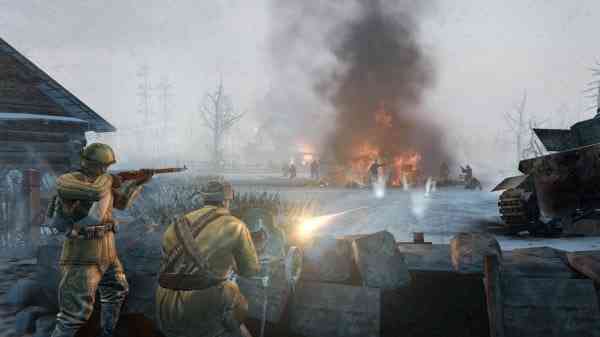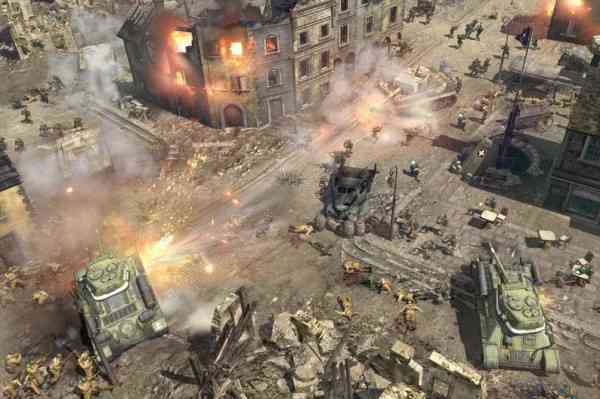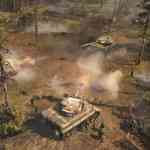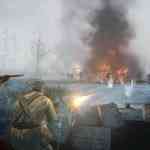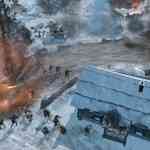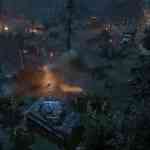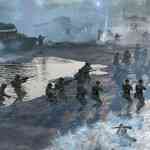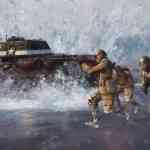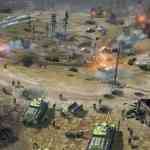Many who enjoy the thrill of action and war in video games will head towards the newest and most popular first person shooters, but there are others who enjoy the more tactical options that the real time strategy genre offers. Company of Heroes 2 by Relic Entertainment is a fine example of this.
As a Russian commander, you take charge of your nation’s army in 1941, fighting off the German forces who are trying to take over your homeland. As is in many RTS games, the battlefield is presented in an isometric view, and you have the ability to zoom in rather close on the action, or out to take a wider view of the battle. You can control your troops in a few ways. You can drag your mouse over a squad of troops to highlight them, then click where you want them to go. Or, you can select a shield icon near the squad to select them, then similarly click where you want them to go, which I found myself using frequently as groups of troops can sometimes overlap each other making it difficult to select them otherwise. This was particularly the case when zoomed out fully.
You can pan the view by moving the mouse to the edges of the screen, but to move around the map faster, a smaller map is displayed at the bottom of the screen which you can click on to jump to that position, and also shows an overview of all your troops, buildings and equipment. Units under attack are also flagged. A key part of the strategic element is the game’s cover system, which encourages you to use the environment to your advantage, making sure your troops are well hidden and shielded (their coverage level is displayed in the main view). You’ll be hiding in trenches, behind walls, sandbags and the like, but some of these are destructible, so you have to keep a watchful eye on how things are going.
The environments offer other useful items, such as weapons that can be picked up by your squads to upgrade their handheld weapons, vehicles, and larger weapons that require more than one troop to use. I found these upgrades very handy at times to survive certain points on the map. The elements can also be quite hazardous to your troops, especially after you reach the winter campaigns. Just like in real life, troops cannot last long in a deep freeze, and require fire and shelters once and awhile, or they will slowly die (their temperature is represented by a small thermometer above their heads). So if you see a bonfire or house, head towards it ASAP or you will lose troops quickly. Deep snow is also a hindrance, as it slows down your troops significantly. Also ice covering water can be broken by heavy weapons fire, and if you find yourself on a patch be careful or else you may find your troops at the bottom of a frozen lake. These winter levels really add an extra element of realism to the genre. I think growing up in Canada, where snow can be a big factor, we can certainly relate to this.
While fighting off the Germans, you are going to need more troops and equipment. You are allowed only so many troops on the field at a time, represented on your HUD at the bottom of the screen with the rest of your resources. You just click the “request troops” option and click on the field of battle where you want them. A small flag will drop on your selected area, and in a minute or so a small group of “Cheap” troops will appear there. I used the word “Cheap” because that is how they are referred to in the game , which seems kind of mean, because they are very expendable. There are other special troops you can request, ranging from snipers, engineers, and riflemen – but these cost resources unlike the “Cheap” troops. All have their own special abilities and can be upgraded if you have additional resources.
In the game you will find you have three kinds of resources: munitions, fuel, and manpower. These are also listed on your HUD at the bottom of the screen, next to your troop limit for the map. The resources slowly increase over time, but the rate can be up by capturing points that have the same resources stored there in caches, or by connecting more captured territory to your base territory. You will also need these resources for buildings and vehicles. This is the first RTS game I have played where you don’t have to really manage resource gathering yourself, which confused me at first.
The game offers a selection of play modes that will suit anyone’s tastes. First off, there is the main single player story campaign, where you lead your Russian troops against the invading German forces. At the start of each map you will get orders from your commanding officer and what he expects you to do in order to successfully drive off the Germans. Each map has a set of goals that sometimes have a time limit to meet. If you fail any of these goals, you lose and have to start over. There is checkpoint system that auto-saves when you reach certain goals. This does come in handy, because the levels can go on for quite a while. You can save at any point, but I often found it better just to restart the map over again or from the autosave, learning from the previous attempts to reach goals more efficiently.
Once you are done with the single player campaigns, you can head over to the multiplayer side of the game. Here you can engage in battles with others, playing as either the Russians or German forces. You can go one-on-one, and up to four-on-four. The rules are simple – whichever side manages to wipe out the other side first wins. Matches can just be for fun, or they can be ranked for bragging rights. You can even add AI players into the mix. Another game play option for the game is the Theater of War. Here you will be offered co-operative scenarios to tackle with friends, solo challenges (which are very tough!), and AI battles. All can be played as Russian or German troops. There is enough gameplay here to keep you going for a long time.
Throughout the game, you earn XP that will level up your profile. You will earn medals for all your achievements, and unlock skins and new colors for your troops and equipment. Also, if you think you have mastered the game and want to show off, you now can thanks to TwitchTV integration.
On the visual side of things the game is beautiful and very detailed for a RTS game. Maps are huge and full of life, with lots of variety in the scenery. The art style of the troops themselves, when zoomed all the way out with the camera reminds me of playing with those tiny plastic army men. The look of the vehicles falls into the same category as your troops do, in that they feel and look like toys, but I don’t think this is a bad thing. They react properly when in motion and firing, and definitely seem to have weight to them.
As you are making your way through the battlefields you will be treated to some of the best orchestrated music I’ve heard in a long time. With its thundering tones and Russian influences, it had my heart racing, and it fit perfectly with the ever-changing mood on the battlefield. All the cut-scenes are fully voiced and work well. The same goes for the voices that can be heard on the battlefield. It can get a bit repetitive, but it never reaches the point of being annoying. Those with a good sound system hooked up to their PC are really going to enjoy the amount of explosions and weapons fire in the game. You may feel you need to duck for cover yourself when a large explosion goes off if your bass is up too high!
Company of Heroes 2 brings the realism and haunting aspects of war to your PC. As a newcomer to this series, this game was a thrill to play. The single player campaign is engaging and enjoyable. I also found it difficult to put down as I was always curious what the next map would bring. The multiplayer aspects only add lasting power to a game that already features a strong single player component. Sure Company of Heroes 2 has some minor flaws but overall this is a very good RTS game from Relic Entertainment.

